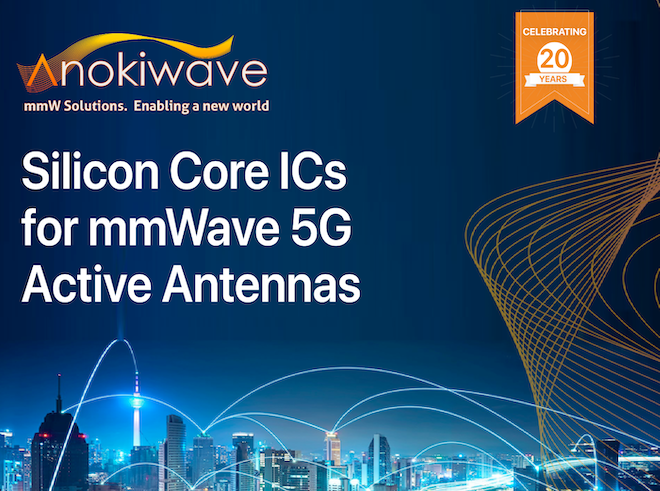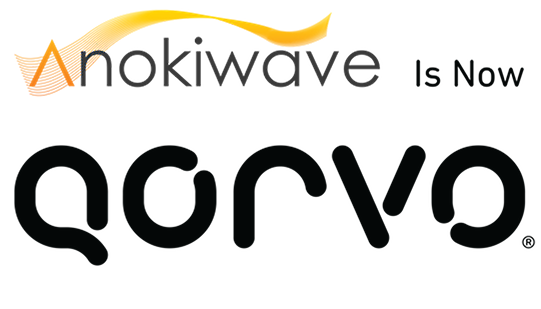What is new at Anokiwave - 20 Years Celebration and mmW 5G is now a Commercial Reality
 |
Alastair Upton |
|---|---|
|
|
|

Skepticism abounded back in 2013, when Anokiwave pivoted away from serving as a design services house for millimeter-wave (mmW) applications and embarked on a course to develop and sell silicon-based mmW ICs for RF front ends and control of active antennas in 5G, radar, and satcom applications.
“ICs made from silicon for use at millimeter-wave frequencies? Not likely!” said some. “Phased array antennas in consumer electronics? That’s science fiction,” said others. “A risky business gamble that will surely fail,” went the refrain.
But Anokiwave didn’t see things that way. Instead, what co-founder and Chairman Nitin Jain and a new management team led by CEO Robert Donahue and Chief Systems Architect David Corman did see, was the coming unprecedented demand for more bandwidth at higher frequencies and the opportunity to capitalize on it by taking advantage of the relentless advances being made in highly cost-effective silicon IC technology.
Today, as Anokiwave celebrates the 20th anniversary of its founding, and with millions of ICs having been shipped in collaboration with our semiconductor foundry partners, that strategy has been proven correct. The 5G market is developing more quickly than anyone expected, and satcom infrastructure opportunities have blossomed as well, driven by traditional satellite communications companies and others who are scrambling to offer data services in the licensed Ku and K/Ka bands. Meanwhile, the capabilities and performance of silicon ICs have advanced by leaps and bounds.
As a result, Anokiwave is in the enviable position of being the industry’s only complete supplier of mmW ICs for all applications and use cases. In 5G, for example, we support everything from macro-cells to customer premises equipment (CPE) in the mmW frequencies that are now in play: the 28 GHz band that was auctioned late last year/early this year; 24/2 6GHz, for which the auction is ongoing as of this writing; and the 37/39 GHz and 47GHz bands scheduled for auction later this year.
Evidence of our industry-leading position can be seen by the response to our recent 5G mmW Array Antenna Design Technology Seminar in Taipei, Taiwan, hosted by DIGITIMES. So many people wanted to attend that we were forced to hold parallel sessions to accommodate everyone.
What’s driving customers to engage with Anokiwave are our mature technologies; unparalleled systems-level knowledge of mmW applications, which other semiconductor companies simply can’t match; and the many advantages of silicon-based ICs versus compound semiconductors, which range from the ease of porting circuit designs across frequency bands to silicon’s superior integration capabilities.
500 Years of Experience in Systems Design and Cost Reduction
We like to say that Anokiwave has about 500 years of systems-level knowledge and experience with silicon core ICs, active antenna ICs, and front-end ICs for millimeter-wave applications. That’s not literally true, of course, but it represents the cumulative experience of Anokiwave’s engineering and management teams. Our knowledge base and intimate familiarity with millimeter-wave challenges and best practices give us a unique, holistic perspective into these applications which, coupled with our strength in chip design, is invaluable to our customers.
This holds true not just for individual customers who need help with specific projects, such as with the design of an optimal antenna array for their system, it’s also true in a larger sense because our products help all customers address universal challenges inherent with operation in these frequency bands.
Take the issue of cost, for example. Low operating costs are fundamental to the success of the 5G rollout now under way, and one way Anokiwave is helping keep them low is with the proprietary ZERO-CAL™ technology embedded in our latest set of 5G solutions. Anokiwave’s ZERO-CAL™ technology eliminates the need for system operators to calibrate antenna arrays. By making time-consuming array alignment and costly factory testing unnecessary, operating costs are reduced even as the predictability of system performance is improved.
In addition, Anokiwave is working intensely to address system energy requirements, because energy costs are a huge component of network operating expenses. A hypothetical mmW 5G-NR network consisting of 500,000 large gNodeB base stations and 5 million small cells, is projected to consume over 2.65 TWh of power in its active antennas. That corresponds to the power consumed annually by 82,000 U.S. homes, or 20% of the power generated by Hoover Dam!
Thanks to the superior integration capability of silicon, Anokiwave can embed power-saving KINETIC-GREEN functionality into our mmW ICs, resulting in a substantial reduction in network operating energy consumption, up to 33%.
Silicon’s integration capability also allows us to place all requisite functions for active antennas on small ICs within the antenna’s radiating element lattice, making low-profile planar form factors and lighter-weight systems possible for commercial 5G, RADAR, and SATCOM applications.
The Next 20 Years
The mmW markets are exciting and dynamic, and as we look forward to the next 20 years, although changes in technology and in the business environment are inevitable, one thing will remain constant: Anokiwave will be there helping customers address their most difficult and important challenges with unique and valuable solutions.

